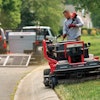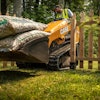
Landscape company owner/operators wear a lot of hats. They not only do the physical work of actually servicing accounts, but also sell and manage, respond to customers and do bookkeeping. The owners of larger landscape companies—who rarely if ever work on a crew anymore—wear many hats of their own; as a company gets bigger, the behind-the-scenes demands grow exponentially.
Whatever your personal situation is, the success of your company largely rests on the backs of your employees doing the work in the field. You must be able to trust them. In order to develop that trust, it's useful to have clear job descriptions in place before placing a new employee into action.
Tony Bass, a business trainer and former contractor, says that when you take a moment to reflect on all of the work that you do, you can start to see how it fits within numerous different roles within your company. For example, when you're out calling on clients on a Monday, you're a salesperson. When you're mowing a huge commercial property on a Tuesday, you're a lawn maintenance technician and/or foreman. When you're planting shrubs at a residential job on a Wednesday, you're an installation technician. When you're doing bookwork at the kitchen table on a Thursday night, you're the administrative manager.
Think about all of the work that your company does. Generally speaking, each type of work can be classified into one of three main areas:
- Operations – the day-to-day functioning of the company, providing services
- Finance – invoicing, paying bills, budgeting, etc.
- Marketing – advertising, sales, networking, customer service, etc.
"Within those three categories, you can find a wide variety of jobs that you, the owner/operator, are probably already wearing hats for," Bass points out. "The more detailed you get with the job descriptions within each of these three main areas, the better job you can do at organizing the work of the company and hiring the right people to do that work."
Getting started
To get started, the first thing you have to ask yourself is: What is the one position that is most frequently available in my company? Whatever your company does the most of—be it lawn maintenance, irrigation system service work, planting trees and shrubs, or whatever—that's where you start with job descriptions.
Let's use the example of a landscape maintenance technician. Begin by outlining a broad overview of the many tasks an employee may be involved with on a repetitive basis. Bass offers the following examples:
- Operate mowers, trimmers, pruners, blowers and other landscape maintenance equipment
- Pull weeds
- Rake lawns
- Seed lawns
- Water lawns, plants and trees
- Spread mulch
- Plant flowers
- Install decorative stone
- Maintain customer properties to best condition possible, including removal of leaves and other debris from patios, plant canopies, flower beds, etc.
- Perform duties to assist landscape maintenance supervisor
These are just a few examples. As you can see, this list can become quite extensive. How extensive simply depends on what tasks you expect your landscape maintenance technicians to perform. One thing that absolutely must be on the list, though, has to do with safety. "The landscape maintenance technician must practice proper crew safety, including the safe and proper use of equipment and tools as assigned to him or her," Bass says emphatically.
After you've completed this most important job description, perform the same exercise for the other positions within your company. This project may sound tedious and time-consuming to some of you. That's because, for the most part, it is. But it's important.
More reasons why job descriptions are important
Think about the service agreements you have with your clients. "A written service agreement outlines what your company is responsible for on a given project," Bass says. "So a job description is like having a service agreement with your team." It is clear, in writing, what each employee's responsibility is and what your expectation is as company owner. That helps to ensure that the end result is what you desire.
Clear job descriptions also help you weed out potentially bad new employees before you make the costly mistake of hiring them. While a job description identifies the numerous tasks a given employee may be expected to execute, it also identifies the different things a given employee may be exposed to on the job.
For example, Bass shares, the job description could include things like: "must be willing to work in hot conditions" and "may encounter spiders and snakes". Making applicants aware of these realities could result in certain applicants withdrawing from the process. That means you have less of a chance of hiring someone who will end up quitting after a week or two on the job.
Here's another example: "Must adhere to proper uniform standards." This might sound overly simplistic, but it's not. A client service agreement might stipulate that members of your crew will wear appropriate uniforms. But how many times does an employee show up to work one day without his uniform? Having clear job descriptions that address the wearing of uniforms helps eliminate this potential problem.
Get super specific with non-field personnel
As landscape companies grow to a half million in sales or so, it's often necessary to begin adding non-field personnel to the payroll. We're talking about administrative staff and sometimes departmental managers. Keep in mind that these types of employees are considered as "overhead" expenses. That is, they aren't directly tied to billable labor/revenue generation. It's really important to have clear job descriptions for these people as you add them to your team.
From a managers standpoint, Bass says he has found that providing a job description detailing responsibilities is only the first step. "You also may need to go as far as suggesting a typical daily routine for that role within your company," Bass explains. "You may also highlight the types of activities these employees should focus on in order to remain highly productive each day."
For example: As an account manager, you are responsible for overseeing some field personnel (crews), in addition to a book of business (list of clients). Therefore, you must juggle the responsibilities of interacting with employees and clients throughout the day. Account managers must also assess weather conditions for the day (at 6:30 a.m.) to determine whether or not crews report to work that day. Account managers then meet with crew foremen (7 a.m.) to review route sheets for the day.
Having systems in place that help get each day off to a good start helps to ensure that the entire day runs more smoothly. Assigning that responsibility to account managers, in writing via the job description, is a great way to make that happen—while also ensuring that your new overhead expense (account manager's salary) makes an immediate contribution to your bottom line.
Of course, it's not set in stone that landscape contractors have to assign the above mentioned duties to their account managers. The point is that you assign those duties—and countless others—to someone via a written job description.

















![Gravely Pro Turn Mach One My23 Dsc03139 Edit 1200x800 5b2df79[1]](https://img.greenindustrypros.com/mindful/acbm/workspaces/default/uploads/2025/10/gravely-pro-turn-mach-one-my23-dsc03139-edit-1200x800-5b2df791.BucBnDoN22.jpg?ar=16%3A9&auto=format%2Ccompress&fit=crop&h=135&q=70&w=240)


